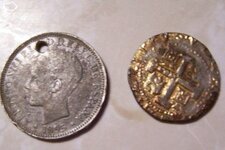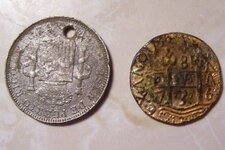D
diggit
Guest
This is my first "today's Finds" post I am a newbie. My husband and I are pretty green to metal detecting but we found these this week around a local farm's pond. I know they are not real (bummer). They were found about 3 feet apart about 5-6 inches deep. The big one is from puerto rico....but there is a hole drilled through it and copy is stamped by the hole. The other made our hearts stop when we first saw it cause it looked like gold and it was unusual to us. Remember we are extreme newbies...especially when it comes to coins. Upon further inspection we realized that they are both fakes of course. My Question is,when were people required to stamp "copy" on fakes? Do you think kids might of bought these as souviners on Vacation or something? Should I clean them or leave them alone? I know they aren't worth much but it was an exciting find regardless!
Heather
Heather
Attachments
Upvote
0





